Magical medieval city of Salamanca, Spain, known throughout Spain as Golden City, because of its honey-colored sandstone, has the distinction of hosting Spain’s oldest university. Founded in 1134, the University of Salamanca is the third-oldest university in Europe, after those of Bologna and Oxford. Salamanca is also known for its food and wine, as well as amazing sights within it Old Town. These include: Plaza Mayor, Casa de las Concha, Old and the New Cathedral, Roman Bridge and Convent de San Esteban. Read on and discover Salamanca along with us!!!
Location
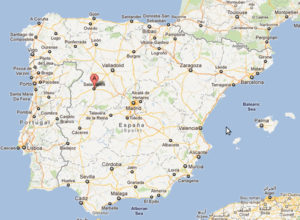
location-Salamanca
Salamanca (Spanish pronunciation: [salaˈmaŋka]) is a city in northwestern Spain that is the capital of the Province of Salamanca in the community of Castile and León. The city lies on several hills by the Tormes River. Its Old City was declared a UNESCO World Heritage Site in 1988. It is situated approximately 200 kilometers (120 miles) west of the Spanish capital Madrid and 80 km (50 mi) east of the Portuguese border.
Getting there
There are numerous bus and train options for a day trip out of Madrid. Both options take about 3 hrs. one way and cost approximately $20 per person each way. However, if you are coming from another location, like we just did from Porto, Portugal, driving is only option. Car ride from Porto, Portugal, takes about 3-4 hrs., and you can hire private transfer at Porto Tours and Transfers. You can combine this trip with drive through Douro Valley by adding additional 2-3 hours.
Brief History
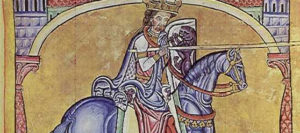
history-Salamanca
Salamanca’s glory days begun during Roman times, and were rekindled during Medieval and Renaissance period as Spain’s premiere University town.
-Roman times
In 220 B.C., the pre-Roman city of Salmantica and its almost 5,000 inhabitants were laid siege to by Carthaginian general Hannibal, assisted by an unexpected troop of some 40 elephants. This episode, which put Salamanca on the map, was simply a precursor of things to come, namely a Roman conquest. In the middle of the 1st Century B.C., the Romans turned Salmantica into a civitas (a political community) and a strategic enclave on the Vía de la Plata, Silver Way trade route. To make things run smoother on this particular stretch (that linked Merida with Astorga), Roman engineers built a large bridgethat still spans the waters of the river Tormes. The town, that at that time belonged to the Roman province of Lusitania, was upgraded to a municipality.
-Medieval period
Towards the end of the 11th Century, French Count Raymond de Bourgogne, repopulated Salamanca with a large group of people, mostly French and Galicians. One of his first tasks was to restore the Episcopal See with Cluniac monk, Jerónimo Visque in 1102. While the different population groups spread out into about 40 parishes, each with their corresponding churches, work started on the construction of the Roman Cathedral, and the ancient Celtic-Iberian and Roman city wall was rebuilt. The 13th Century brought with it many changes, some of them essential for the future of Salamanca. In addition to the charters granted by King Alfonso IX of Leon that attracted new immigrants, including a large Jewish community, the city had its outer walls extended, and in 1218, a turning point for Salamanca, the Estudios Generales (General School), precursor to the future University, was created.
-Renaissance
After the crisis of the 14th Century, experienced to a large extent by the whole of the European continent, and a conflictive 15th Century, marked by feudal unrest and the Guerra de los Bandos (War of the Bands), Salamanca entered the 16th Century adamant that it was to become the largest renaissance city of the whole Iberian peninsula. Social and economic prosperity, thanks to trade and commerce, income from the latifundia (large estates) and the production of wool aided by the Mesta (powerful association of sheep holders), helped the population to grow to some 25,000 inhabitants. A number of palaces, large town houses, convents, colleges and university colleges were also built using a very characteristic and autochthonous architectural style: the plateresque.
Layout
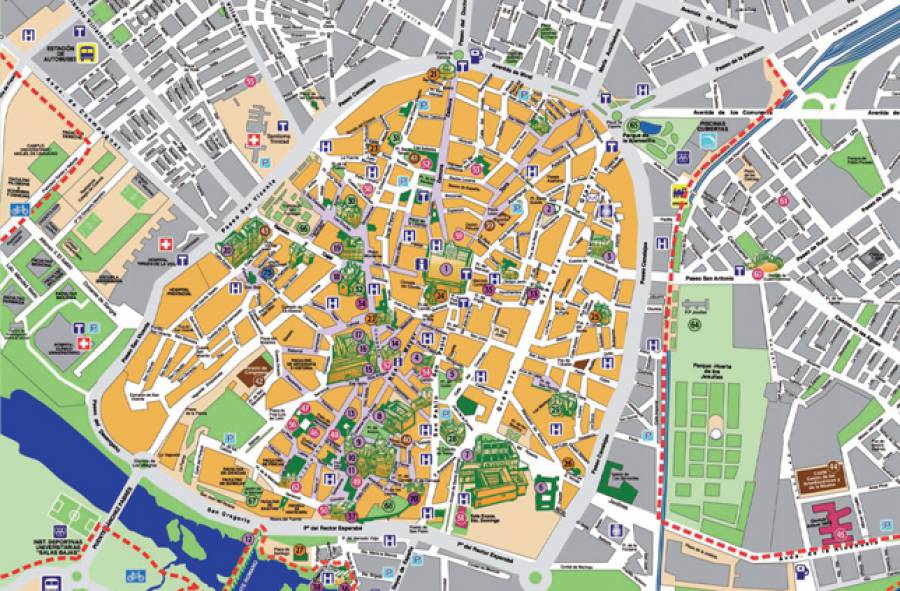
Salamanca-map
Salamanca’s Old Town lies on the bank of Tormes River within confines of what used to be a medieval city walls. Most of the defensive walls do not exists, as they were teared down and turned into wide streets. Salamanca’ Old Town is a very walkable city. It’s medieval street grid makes it a bit confusing, but most streets will lead to Plaza Mayor, and. You can use bell tower of the cathedral as a map reference. All major tourist sights and restaurants are within 10-15 minutes walk. So put comfortable shoes on!
Perfect day in Salamanca
We started our perfect day in Salamanca with just some coffee and no breakfast. Let’s just say, we needed some break to digest all the delicious food we ate in Portugal. Our hotel, Hospes Palacio de San Esteban, was perfectly located within Old Town, just steps from our first stop, Iglesia-Convento de San Esteban.
Iglesia-Convento de San Esteban
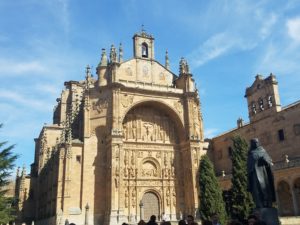
Salamanca, Church and Convent of San Estaban
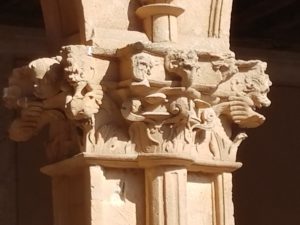
Salamanca, Church and Convent of San Estaban9

Salamanca, Church and Convent of San Estaban

Salamanca, Church and Convent of San Estaban
16th-century church of this Dominican monastery has an ornamented façade. The relief on the central panel, completed by Juan Antonio Ceroni in 1610, depicts the stoning of St Stephen, to whom the monastery is dedicated. Above is a frieze with figures of children and horses. The interior is equally stunning. The ornate altarpiece, of twisted gilt columns decorated with vines, is the work of José Churriguera and dates from 1693. Below it is one of Claudio Coello’s last paintings, another representation of the martyrdom of St Stephen. The double-galleried Claustro de los Reyes, completed in Plateresque style in 1591, has capitals that are carved with the heads of the prophets.
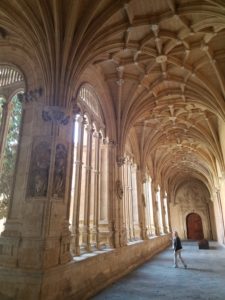
Salamanca, Church and Convent of San Estaban9

Salamanca, Church and Convent of San Estaban9

Salamanca, Church and Convent of San Estaban
Catedral Vieja and Catedral Nueva
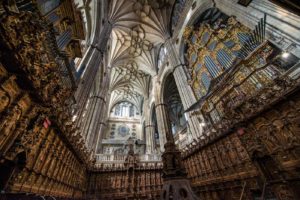
cathedral-choir

Salamanca Cathedra

Salamanca Cathedra
Keeping up with the theme, our next step was towering Salamanca Cathedral, which is actually 2 cathedrals in one: New and Old. The New Cathedral (built during the 16th–18th centuries) did not replace the old, but was built beside it. It combines a mix of styles, being mainly Gothic, with Renaissance and Baroque additions. The west front has elaborate Late Gothic stonework. The 12th- to 13th-century Romanesque old cathedral is entered through the new one. The highlight is a 53-panel altarpiece, painted in lustrous colors by Nicolás Florentino. It frames a statue of Salamanca’s patron saint, the 12th-century Virgen de la Vega, crafted in Limoges enamel. In the vault above is a fresco depicting scenes from the Last Judgment, also by Florentino. The
15th-century Capilla de Anaya (Anaya Chapel) contains the superb 15th-century alabaster tomb of Diego de Anaya, an archbishop of Salamanca.
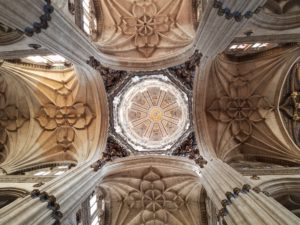
Salamanca Cathedra
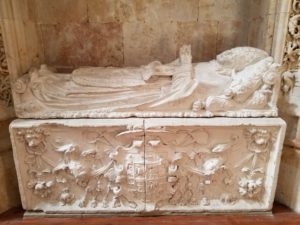
Salamanca Cathedra
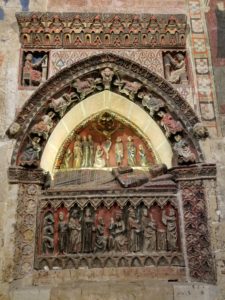
Salamanca Cathedra
Casa de las Concha
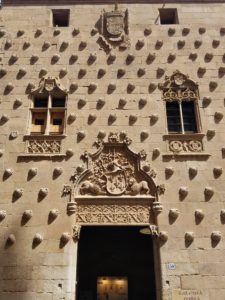
House of Shells

House of Shells
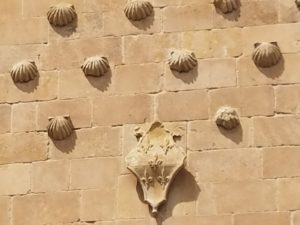
House of Shells
Just steps from the cathedral is a the House of Shells, one of the most famous sights in Salamanca. This mansion’s name – House of the Shells – derives from the stone scallop shells that cover its walls. They are a symbol of the Order of Santiago, one of whose knights, Rodrigo Arias Maldonado, built the mansion in the early 1500s. He also adorned it with his family’s coat of arms. It now houses a public library.
Plaza Mayor

Spain-Salamanca-Plaza-Mayor-nighttime
This 18th-century square is one of Spain’s largest and grandest. On the east side is the Royal Pavilion, decorated with a bust of Felipe V, who built the square. It houses different stores and restaurants, and is always alive with tourists and students from nearby University. This magnificent square was built by Felipe V to thank the city for its support during the War of the Spanish Succession. Designed by the Churriguera brothers in 1729 and completed in 1755, it was once used for bullfights, but nowadays is a delightful place to stroll or shop. Within the harmonious blend of arcaded buildings and cafés are the Baroque town hall and, opposite, the Royal Pavilion, from where the royal family used to watch events in the square. The Plaza Mayor is built of warm golden sandstone, and is especially splendid at dusk.
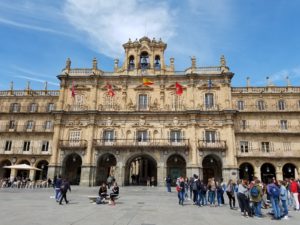
Plaza-Mayor
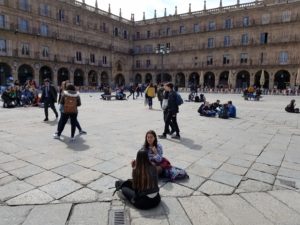
Plaza-Mayor
Lunch in Plaza Mayor
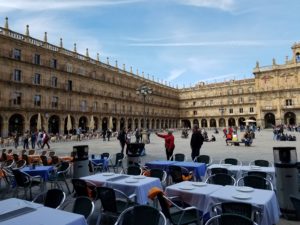
Plaza-mayor-lunch
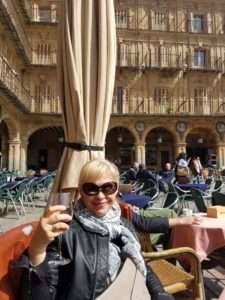
Plaza-mayor-lunch
This is perfect time to break for lunch. Pick a seat in one of the cafes and restaurants lining the square and order lunch (what we just did) or a drink and watch street performers. Notice the sun playing with the facades of the buildings, giving Salamanca its nickname: Golden City. This is a perfect place to just relax and reflect on your travels. Come back for a dinner, and watch the city illuminated by street lights.
Universidad de Salamanca
After delicious lunch and few glasses of wine, it was time to visit the Oldest Spanish University, celebrating this year its 800th Anniversary.
The university was founded by Alfonso IX of León in 1218, making it the oldest in Spain and third-oldest university in Europe, after those of Bologna and Oxford. The 16th-century façade of the Patio de las Escuelas (Schools Square) is a perfect example of the Plateresque style. Opposite is a statue of Fray Luis de León, who taught theology here. His former lecture room is preserved in its original style. The Escuelas Menores building houses a huge zodiac fresco, The Salamanca Sky.

Salamanca-University

Salamanca-University

Salamanca-University-courtyard
Casa Lis Museo Art Nouveau y Art Deco
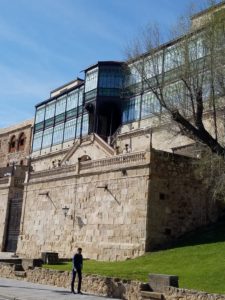
Museo Art Nouveau
Walking toward the river and Roman bridge, we passed unique glass façade of Casa Lis Museo Art Nouveau y Art Deco. This museum houses an important art collection, housed in a 19th-century building, includes paintings, jewelry and furniture from all over Europe. Individual rooms are devoted to porcelain and Limoges enamel, and stained glass work by Lalique. It would be too much for us to see in just one day in Salamanca, but if you are staying longer, do visit.
Puente Romano

Roman-Bridge
Our last stop was crossing the Roman bridge, built in the 1st century AD, to the other side of Tormes river. It still retains 15 of its original 26 arches. While walking through it take an opportunity to take some of the best pictures of Salamanca and the Old Town. Marvel at the Roman engineering that lasted for millennials while modern bridges collapse after just decades.
After all this walking it was a time for a quick stop by our hotel and nap before dinner.
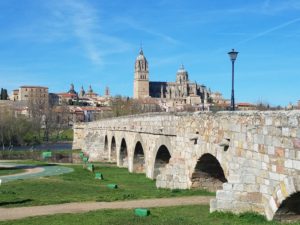
Roman-Bridge
Dinner
At 9 pm we walked back to the Plaza Mayor and sat by an upstairs window of one of many restaurants serving local food. April evenings can be chilly in Salamanca, and all restaurants have plenty of inside and outside seating. Do keep in mind, that tapas can only be ordered by the bar area, so if you choose one of the prime seating with a view, you might have to order from the main menu. Once you do that, you can add tapas later on. We enjoyed Spanish dinner and wine, watching sun set over Salamanca. Walking back to the hotel, we took in beautifully lit historic buildings and enjoyed city empty of tourists.
Salamanca at Night
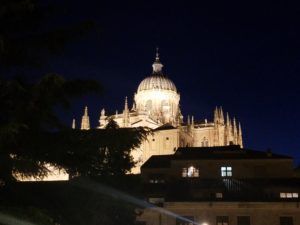

Salamanca-at-night
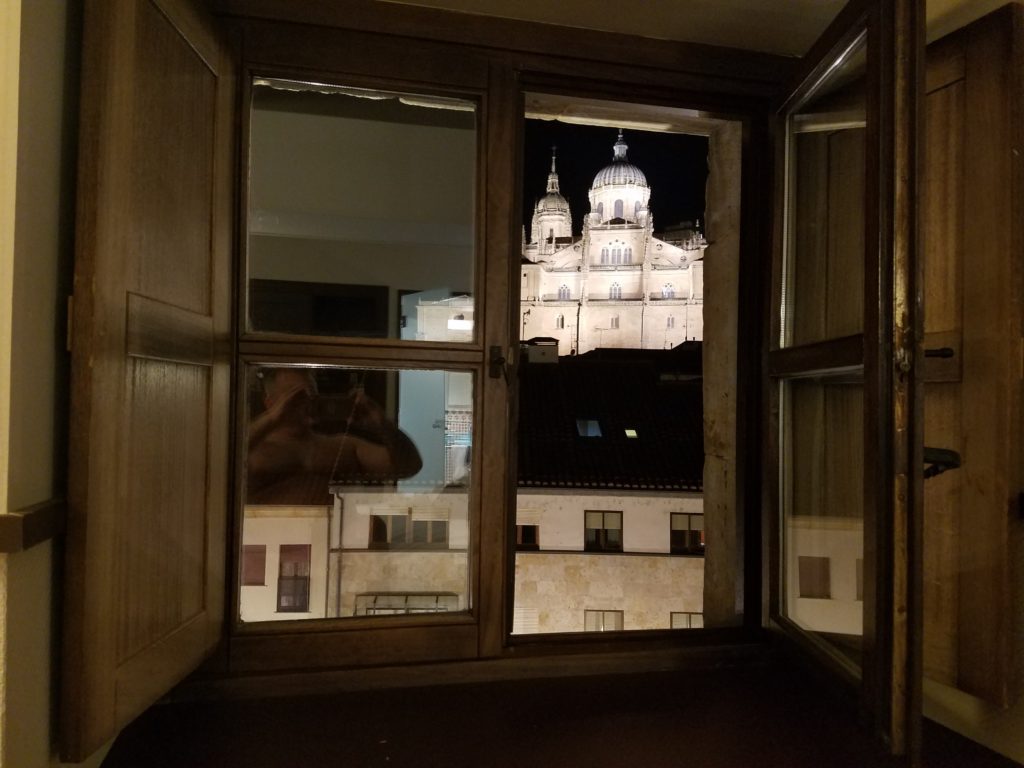
View-from-hotel-room

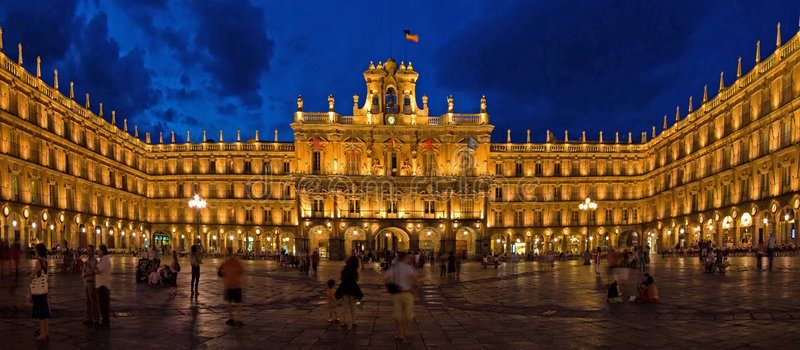
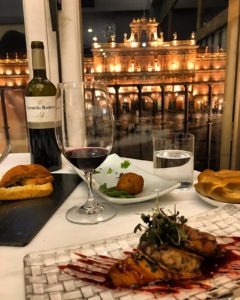
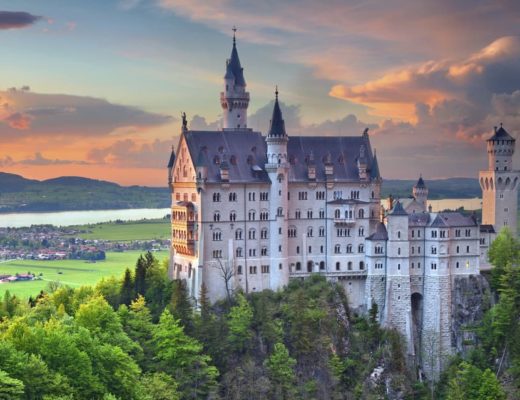
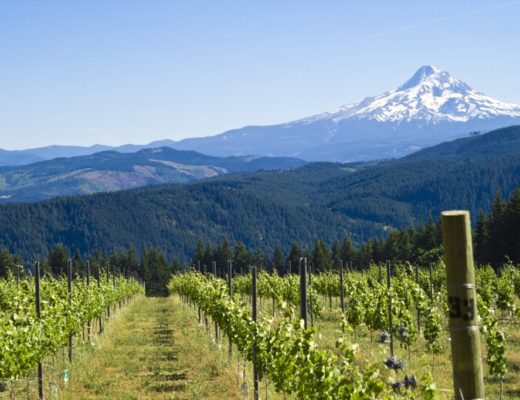
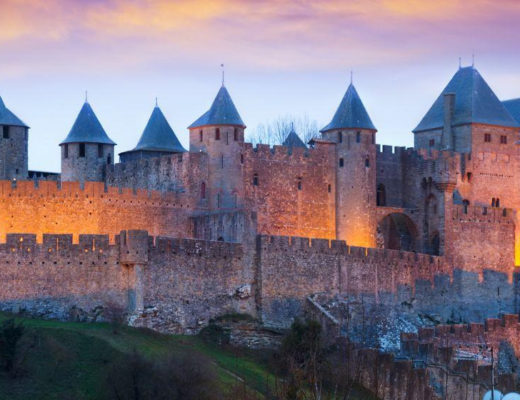
Review: AC Hotel Ciudad de Toledo, Spain - PointsTravels
July 17, 2018 at 7:29 pm[…] Maps did a great job taking us from Salamanca, Spain, straight to the hotel parking lot. This is not a luxury chain hotel, so there is no dedicated […]